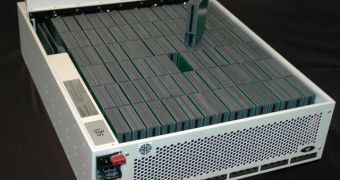Intel's highly successful Atom processor, which currently powers most of the recently released netbook, nettop and low-power computer systems on the market, could actually be used to power a computer system that would normally be used for highly demanding applications. A concept of such a high-performance computer system, called Molecule, has recently been created by high-performance specialist Silicon Graphics. The Molecule concept computer has been designed using mostly off-the-shelf consumer electronics components, which, brought together, make for 10,000 cores packed inside a single rack.
The interesting thing about the Molecule is that it is powered by an Intel processor that the Santa Clara, California-based chip maker released as an alternative computing solution for low-power, low-cost computer systems, coming to provide a basic computing experience. However, Intel's Atom 330 role in the Molecule concept computer is somewhat different, as it has been chosen for a computer system meant to overcome some of the limits supercomputers face today.
The Molecule computer can handle 20,000 threads of execution thanks to its two built-in cores and its Multi-threading technology. This high figure marks 40 times more threads than a single rack x86 cluster system. The computing power and memory bandwidth delivered by the SGI-designed Molecule can be compared with those delivered by more than 750 high-end PCs, while requiring half the power, and using less than 1.4 percent of the physical space.
"The Molecule concept computer balances processor speed, sustained memory bandwidth and power consumption," says SGI in a statement.
Such a computer system would provide an alternative market for Intel's low-power Atom processor, especially since these CPUs are basically featured in consumer desktop PCs that are good at providing a good Internet experience and the basics in computing. Nevertheless, as far as playing the latest gaming applications goes, such Atom-powered systems perform relatively poorly.

 14 DAY TRIAL //
14 DAY TRIAL //